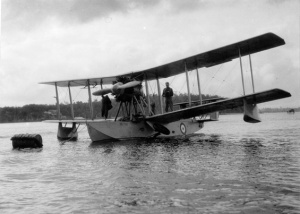Wackett Widgeon II
| Type |
Spotter/Reconnaissance Amphibian |
|---|---|
| Length |
29 ft 6.75 in (9.0107 m) |
| Height |
14 ft 0.75 in (4.2863 m) to tip of propeller |
| Wingspan |
29 ft 3.75 in (8.9345 m) |
| Weights |
|
| Speed | 103 mph (166 km/h; 90kn) at sea level |
| Endurance | 3 hours |
| Altitude | 11,000 ft (3,400 m) |
| Crew |
1 |
| Engines | 1 x ADC Nimbus 6-cylinder inline water-cooled engine, 300hp (220 kW) |
| Ships embarked in | HMAS Albatross (I) |
The Wackett Widgeon II seaplane was built by the Experimental Section of the Royal Australian Air Force (RAAF) at Randwick, NSW during the 1925-26. It was a single-engine amphibian biplane of wooden construction and only two of its type were built.
The Widgeon was designed by Squadron Leader Lawrence James Wackett during 1923. Wackett was born in Townsville in 1896 and served in the Australian Flying Corps during World War I before joining the fledgling RAAF in 1921. His younger brother Ellis Wackett, born 1901, joined the RAN College as a cadet midshipman in 1915 and qualified as an Engineer Lieutenant in 1923 before transferring to the RAAF later that year in order to qualify as a pilot.
The first prototype, the Widgeon I, was built during 1924-25 as a seaplane (only able to take off and land on water) and crashed during it its test flight at Botany Bay in July 1925. Repairs took five months to complete and following a successful flight, on 3 December 1925, a number of modifications were made including conversion of the aircraft to an amphibian; able to take off from land or water. At the same time as the Widgeon I was being modified the Widgeon II was under construction.
Taxiing tests of the Widgeon II commenced on 16 February 1928, at Mascot Aerodrome, and the aircraft first took to the air on 21 February. The Widgeon II was handed over to the RAAF, at Point Cook, on 13 April 1928 after flying from Mascot. In May 1928 the Widgeon II flew from Melbourne to Darwin with the intention of flying on to Singapore to rendezvous with the Supermarine Southampton II flying boats, of the Royal Air Force Far East Flight, for the Australian leg of their "great flying-boat cruise". However the Widgeon II was not able to take off from Darwin due to its heavy load and hot tropical conditions.
Squadron Leader Wackett flew the Widgeon II along the coast to Broome and met the RAF aircraft there on 1 June 1928. The Widgeon then accompanied the four RAF flying boats to Melbourne, with stops at Port Hedland, Carnarvon, Perth, Ceduna and Adelaide. The five flying boats arrived in Melbourne on 29 June 1928.
The Widgeon II returned to Mascot in August for modifications, following its lengthy flight and in July 1929 was embarked in the seaplane carrier HMAS Albatross for a voyage of the New Guinea area to conduct flight trials under tropical conditions. At Rabaul during 16-18 July the Widgeon was craned off for test flights but failed to launch despite several attempts. The aircraft was craned back onboard Albatross and not used again. The Widgeon II was returned to Point Cook in late October 1929 and handed over to the Civil Air Board.
On 6 January 1930 the Widgeon II took off from Point Cook for a test flight but soon after crashed into Port Phillip Bay killing the pilot and two passengers.




